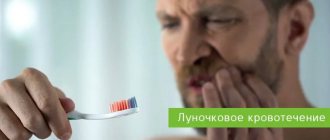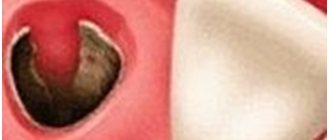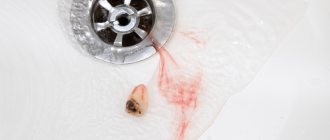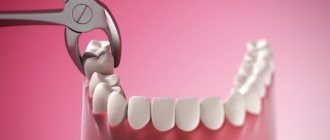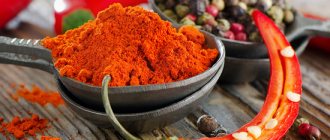Blood when brushing your teeth can be one of the signs of periodontal disease, gingivitis, or other serious problems in the oral cavity. Other symptoms such as extremely bad breath, toothache, and gum disease indicate poor oral hygiene and its complications.
Gum inflammation affects the tissues that surround and support the teeth. Bacteria colonize the teeth and can turn into tartar and cause irritation of the gums, leading to bleeding, recession, and gum inflammation. Good oral hygiene reduces bleeding gums.
Self-help: ways to stop bleeding
When blood bleeds for a long time after the removal of a wisdom tooth, it brings discomfort on a physical and emotional level. If you can't get to the dentist, use gauze swabs. Fold a small piece of bandage into several layers, apply it to the hole and bite firmly. Keep for 20 minutes. To disinfect, you can soak a swab in hydrogen peroxide. Bleeding after wisdom tooth removal can be stopped by this method both day and night. Another option is to use ice. Apply to your cheek and apply for 5 minutes with short pauses. If the patient has a history of hypertension, a high blood pressure pill should be taken.
Causes
The most common factors that lead to bleeding gums are:
- Improper oral hygiene:
using a brush with hard bristles, strong pressure when brushing, inaccurate use of dental floss, picking with toothpicks and other objects, improper installation of dentures. Due to frequent trauma, gum pockets form, which provoke inflammation.
- Tartar.
With irregular and improper brushing of teeth, plaque forms, which gradually hardens. The stone moves the gum away from the tooth, the tissue becomes inflamed and begins to bleed.
- Dental procedures.
Bleeding may occur after professional cleaning, tooth extraction, or the installation of a filling or implant. A poorly manufactured or fitted structure constantly injures the edge of the gum. In addition, filling material and dentures can cause an allergic reaction.
- Diseases of gums and teeth:
gingivitis, periodontitis, periodontal disease. Inflammatory processes are accompanied by swelling, swelling, exposure of the neck, abrasion and loosening of teeth.
- Infections and viruses.
Herpes, fungus, tonsillitis, influenza, ARVI, tuberculosis, HIV lead to the destruction of the periodontal structure and provoke inflammatory processes in the oral cavity.
- Hypovitaminosis.
Bleeding from the gums occurs when there is a deficiency of vitamins B, K, C, E. A monotonous and unbalanced diet, frequent diets, and inducing vomiting lead to pathology. With a lack of vitamin C, scurvy can develop. During the disease, teeth become loose and begin to fall out.
- Hormonal disbalance.
The problem is observed during pregnancy and puberty, with diabetes. Due to an imbalance of biologically active substances, tissues swell and become looser. In this case, bleeding from the gums occurs not only when brushing teeth and eating solid food, but also from the slightest touch.
- Taking a number of medications.
Blood thinners, including Aspirin, Heparin, and Warfarin, can lead to the problem. Some nonsteroidal anti-inflammatory drugs have similar side effects.
- Blood diseases.
Bleeding disorders often lead to gum pathology: hemophilia, thrombocytopenia. The condition of the mucous membranes also worsens with tumor processes - leukemia and leukemia.
Folk recipes
Of course, herbal decoctions and juices are not able to completely cure gums that bleed when brushing your teeth. However, natural compounds can become excellent therapy assistants, reduce pain, reduce bleeding, and most importantly, significantly speed up treatment.
The most popular remedies for bleeding gums are:
- A decoction of blueberries will help quickly get rid of even severe bleeding.
- A decoction of oak bark is effective for almost all gum diseases.
- Sage decoction provides antibacterial and anti-inflammatory effects.
- Chamomile has analgesic, anti-inflammatory and antimicrobial effects. A decoction of this plant helps with gingivitis, stomatitis, periodontal disease, and for the prevention of gum inflammation.
- Lemon and black radish will provide reliable protection of teeth from plaque and gums from inflammation.
- An effective means of preventing gum inflammation is water pepper tincture. This healing composition increases the density of the walls of blood vessels, increasing blood clotting.
- Onion and aloe juice are also used to prevent and treat inflammation. These plants (in equal parts) can be applied as applications to the gums twice a day.
To prevent bleeding and inflammation of the gums, it is necessary to eat raw carrots, apples, celery, pears, radishes and other hard fruits and vegetables. Such food will not only enrich the body with vitamins, but will also provide excellent natural massage of the gums and cleanse the enamel of plaque.
Sources:
- Clinical and laboratory assessment of the influence of domestic therapeutic and prophylactic toothpaste based on plant extracts on the condition of the oral cavity in patients with simple marginal gingivitis. Doctor of Medical Sciences, Professor Elovikova T.M.1, Candidate of Chemical Sciences, Associate Professor Ermishina E.Yu. 2, Doctor of Technical Sciences Associate Professor Belokonova N.A. 2 Department of Therapeutic Dentistry USMU1, Department of General Chemistry USMU2
- The effectiveness of the use of Asept “adhesive balm” and Asept “gel with propolis” in the treatment of chronic generalized periodontitis and gingivitis in the acute stage (Municipal Dental Clinic No. 4, Bryansk, Kaminskaya T. M. Head of the therapeutic department Kaminskaya Tatyana Mikhailovna MUZ City Dental Clinic No. 4, Bryansk
- Study of the clinical effectiveness of treatment and prophylactic agents of the Asepta line in the treatment of inflammatory periodontal diseases (A.I. Grudyanov, I.Yu. Aleksandrovskaya, V.Yu. Korzunina) A.I. GRUDYANOV, Doctor of Medical Sciences, Prof., Head of Department I.Yu. ALEXANDROVSKAYA, Ph.D. V.Yu. KORZUNINA, asp. Department of Periodontology, Central Research Institute of Dentistry and Maxillofacial Surgery, Rosmedtekhnologii, Moscow
- The role of anti-inflammatory rinse in the treatment of periodontal diseases (L.Yu. Orekhova, A.A. Leontyev, S.B. Ulitovsky) L.Yu. OREKHOVA, Doctor of Medical Sciences, Prof., Head of Department; A.A. LEONTIEV, dentist; S.B. ULITOVSKY, Doctor of Medical Sciences, Prof. Department of Therapeutic Dentistry of St. Petersburg State Medical University named after. acad. I. P. Pavlova
- Report on the determination/confirmation of the preventive properties of personal oral hygiene products “ASEPTA PLUS” Remineralization doctor-researcher A.A. Leontyev, head Department of Preventive Dentistry, Doctor of Medical Sciences, Professor S.B. Ulitovsky First St. Petersburg State Medical University named after. acad. I.P. Pavlova, Department of Preventive Dentistry
- Clinical studies of antisensitive toothpaste “Asepta Sensitive” (A.A. Leontyev, O.V. Kalinina, S.B. Ulitovsky) A.A. LEONTIEV, dentist O.V. KALININA, dentist S.B. ULITOVSKY, Doctor of Medical Sciences, Prof. Department of Therapeutic Dentistry, St. Petersburg State Medical University named after. acad. I.P. Pavlova
Gastrointestinal bleeding
Blood from the mouth may be accompanied by vomiting
Bleeding can occur in a variety of parts of the gastrointestinal tract. The main symptom is the appearance of blood in a person’s stool or vomit. It can be hidden and detected only with the help of specially conducted tests. In situations where blood from the mouth is caused by some kind of disease of the digestive system, it often goes along with vomiting.
In some cases, vomiting accompanied by slight bleeding may indicate a burst vessel in the throat or esophagus. But most often bleeding indicates the following diseases:
- stomach or duodenal ulcer
- erosion of the mucous membrane of the stomach or esophagus
- liver cirrhosis in severe stages
Ulcers provoke up to eighty cases of bleeding occurring in the gastrointestinal tract. In addition, due to bleeding, diseases such as enteritis, colitis, polyps, gastritis, duodenitis and others become aggravated. It also causes complications of cancer in any part of the digestive system.
The most severe form of blood effusion in the gastrointestinal tract is considered to be its loss through the veins of the esophagus, which occurs with portal hypertension. Sometimes severe bleeding occurs as a result of hemorrhoids. The use of certain medications in some situations causes the development of bleeding.
Gums bleed when brushing teeth
With all of the listed diseases and health problems, this symptom may appear. But in some cases, bleeding is caused by using a toothbrush that is too hard. Doctors usually recommend that this hygiene item should not be soft, otherwise it will not be able to effectively cope with plaque that settles on the teeth and oral tissues.
However, if it is too hard, it is capable of causing mechanical damage to the latter, even scratching them until they bleed. They are especially susceptible to this, being too sensitive. To avoid this, you should consult your doctor about which brush is right for your case.
If your gums bleed when brushing your teeth, you may be performing this procedure incorrectly - you are making too intense, pressing movements, which cause tissue injury.
In both cases, an incorrect approach to hygiene measures can lead to gums receding over time and the necks of teeth becoming exposed. The main symptoms of this phenomenon are that the latter visually lengthen, their root part, which has a darker color than the crown part, is revealed to the eye. Their sensitivity increases, as the problem progresses, they become looser and subsequently fall out.
Why do my gums bleed?
They are a mucous membrane that covers the alveolar part of the lower jaw and the alveolar process of the upper. This shell wraps around the teeth in the area of their neck, protecting dental tissues from various damages, and the teeth themselves from falling out.
Bleeding of this mucous membrane, as a rule, is a symptom of some disease of the oral cavity or body. Under the influence of various factors, the tissues are weakened, and, as a result, the gums bleed. These are the reasons why this problem appears. They will be discussed in more detail below.
Why shouldn’t bleeding gums be ignored?
Firstly, you will be haunted by bad breath, which will repel both those around you and those close to you. You will become more complex and less sociable.
And secondly, if you refuse treatment, you can lose healthy teeth. Bleeding gums can be caused by periodontitis, periodontal disease, stomatitis and gingivitis.
Treatment methods
If you find that there is bleeding from your gums, you should immediately contact your dentist. The doctor will determine the cause and prescribe adequate treatment. The most effective ways to combat bleeding gums are:
- Professional teeth cleaning and ultrasonic calculus removal.
Waves completely eliminate plaque. During pregnancy, methods that are safe for the fetus are used.
- Rinse with antiseptics.
Chlorhexidine, Miramistin, Rotokan, Chlorphyllipt, Furacilin, Tantum Verde, etc. are prescribed as a solution for sanitation. It is acceptable to use decoctions of sage, chamomile, calendula, and oak bark. The procedure is carried out in the morning, before bed and after each meal. The course lasts no more than 10 days.
- Dental gels and ointments.
The most effective drugs are Metrogyl Denta, Asepta, Dental, Cholisal, Parodium, Stomatofit, Solcoseryl, Salvin. The composition quickly penetrates the mucous membrane, has an antimicrobial effect, relieves inflammation, pain and bleeding. The products are applied twice a day, after rinsing and drying with a cotton swab.
- Additional medications.
For concomitant diseases of the oral cavity, antibiotics, painkillers, “Parodontocid” spray, lozenges Septolete, Faringosept, Grammidin, etc. are prescribed.
- Physiotherapy.
Gum restoration is accelerated by procedures such as ultraviolet irradiation, electrophoresis, current treatment, oxygen treatment, balneo-, light- and vacuum therapy. Various types of massage are effective: water, hardware, manual. As a rule, a course of physiotherapy includes 5 procedures.
- Proper oral care.
It is necessary to brush your teeth twice a day. Dentists recommend using only soft brushes marked Soft and pastes for bleeding gums: Parodontax, Lacalut, ROCS, BlanX, Mexidol Dent. After eating, you need to carefully remove food debris with dental floss and use an alcohol-free mouth rinse: Silca, Lacalut, PresiDent, Forest Balm. You can also use a solution of water with salt or hydrogen peroxide.
- Taking vitamin complexes and immunomodulators.
Popular drugs are “Dentovitus”, “Alphabet”, “Vitrum”, “Immunal”, “Calcinova”, “Calcium D3 Nycomed”, and lemongrass tincture. To reduce the fragility of capillaries, Ascorutin is additionally prescribed.
- Nutrition correction.
It is recommended to avoid sugar, bread, spicy, sour and salty foods, carbonated drinks and alcohol. The diet should include fresh juices, vegetables and fruits, foods rich in protein, vitamins C, B, K, E. As a result, periodontal tissue will be strengthened, and the mucous membranes will recover faster. Spices are also useful: ginger, wasabi, sesame, cinnamon. Spices stop the proliferation of bacteria and relieve inflammation.
There are also emergency measures. If there is bleeding from the gums, it is necessary to apply a swab soaked in ice water to the tissue. This will quickly soothe the gums and stop bleeding.
The best treatment is prevention. Visit your dentist twice a year. A specialist will detect and eliminate all problems with teeth and gums in a timely manner. If you follow your doctor's recommendations, you will forever forget about bleeding gums.
This article is for informational purposes only, please consult your doctor for details! Ask your doctor about contraindications and side effects.
What is the main danger of capillary bleeding?
First aid for capillary bleeding should not be called an unnecessary procedure. Compared to arterial and venous bleeding, capillary bleeding is not so dangerous, and in most cases the body copes with it on its own. But there are situations that are life-threatening:
- the skin is extensively damaged;
- the ambient temperature is increased;
- blood clotting is impaired;
- There is blood poisoning, oncology, hepatitis, arterial hypertension and other severe pathologies.
The most dangerous is bleeding as a result of damage to the blood vessels of internal organs. Prolonged bleeding provokes a decrease in blood pressure, oxygen starvation, and disruption of the cardiovascular system. If the blood loss is severe, the person dies without treatment. Hemorrhage in the brain affects important centers and also leads to a fatal outcome. Pleural bleeding disrupts breathing and puts pressure on the lung. In most cases, it is important to react in time to manifestations of capillary bleeding and provide first aid in a timely manner.
Emergency care for arterial bleeding
Remember that in case of arterial bleeding you cannot hesitate!
Quickly assess the situation and proceed to provide assistance. First of all, pinch the artery with your finger:
If bleeding is in the face area, press your finger on the corner of the lower jaw.
If bleeding is from the head area, then press your finger on the temporal bone in front of the ear.
If bleeding is in the area of the shoulder joint, then press the subclavian artery to the rib.
If bleeding is in the area of the hand, then press the brachial artery to the bone from the side of the shoulder.
If there is bleeding in the thigh area, then you need to press your fist on the frontal bone in the groin area.
Next you need to apply a tourniquet. To temporarily stop arterial bleeding, an Esmarch tourniquet or improvised rubber material is used. Rules for applying a tourniquet:
- Raise, if possible, the victim's arm/leg - this will lead to the outflow of venous blood from the limb;
- Place the tourniquet over the victim’s clothing or a piece of fabric: this is necessary so as not to injure the person’s skin.
- The first 2 turns need to be made the tightest, the crosshair is applied on the back side of the artery. Make sure that the bleeding from the wound has stopped and the skin below the tourniquet has turned pale.
- The victim should be immediately sent to the hospital or call an ambulance.
If you do not achieve complete disappearance of the pulse on the radial artery, then within 10-15 minutes the hand will swell and turn blue. Then the tourniquet can be removed only if the arm is amputated. Record the time of application of the tourniquet. The maximum permissible time in summer is 90 minutes, in winter – 60 minutes, otherwise tissue necrosis occurs.
Every 30-40 minutes, regardless of the time of year, you should remove the tourniquet for 20-30 seconds (until the skin below its application turns pink). This is done so that blood can enter the damaged limb to supply it with oxygen and remove metabolic products.
Then the tourniquet should be applied again below or above its previous location. You can do this for several hours.

